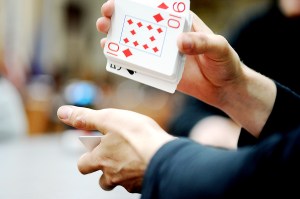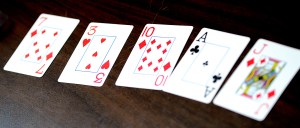Whether or not you actually play poker, there’s no denying that the game has pervaded our culture.
Among the seemingly endless varieties of poker in existence, Texas Hold’em, a game played with a combination of hidden and community cards, has emerged over the last couple of decades as perhaps the most popular, thanks in part to TV shows like the annual World Series of Poker and the year-round World Poker Tour.
Unlike those high-stakes players, though, players in central and western Maine don’t have to come up with a $25,000 buy-in, or travel to Vegas or Los Angeles, to enjoy a game of Texas Hold’em.
“We have a $35 buy-in, so instead of spending $100 or $200 at the casino, you can come here and spend two or three hours for less than $50, including food. Most people can afford to spend that in a week,” said Bob Lavertu, commander of American Legion Post 112 in Oxford, which hosts a monthly Texas Hold’em tournament.
The Oxford American Legion is just one of a growing number of Legions, Lions Clubs and other fraternal orders throughout Maine to host regular public tournaments with relatively low buy-ins.
Lavertu added Texas Hold’em to the club’s schedule of games, such as bingo and cribbage, just a few months ago in an effort to reach out to a younger crowd. Right now, the club, which engages in a number of charitable pursuits — including supporting the Girl Scouts, Boy Scouts, Helping Hands Food Pantry and providing ball fields for the town — has historically made the majority of its income from bingo.
“The people who come for bingo are all older, and the crowd isn’t getting any younger, so we’re losing our bingo crowd faster than we’re bringing them in,” said Lavertu.
Texas Hold’em attracts a much more diverse group, with both men and women ranging from their early 20s through their late 70s. Lavertu believes part of the draw is that it isn’t simply a game of chance.
“It’s a challenge. The game of poker is relatively easy to learn, but to master it is more difficult. You have to be able to bluff. You might not have anything in your hand, and you could still end up a big winner,” he said.
Another aspect that attracts younger people is the game’s pop culture appeal.
Bigger buy-in, bigger pots
First developed in the early 1900s, Texas Hold’em went on to become a popular casino game in the 1960s. Interest exploded about a decade ago, when World Series of Poker and World Poker Tour began to air, filling viewers’ heads with dollar signs as they watched seemingly average Joes and Janes win pots of thousands, or even millions, of dollars.
The game has even been featured in major films, from 1998’s “Rounders,” starring Matt Damon and Ed Norton, to the 2006 Bond adventure “Casino Royale.”
Like many people today, Lavertu was first drawn to the game by watching it on TV, so he ventured out to American Legion Past 150 in Mechanic Falls, which has been hosting regular Friday night games for a few years, to give it a try.
“They always seem to have 60 or 70 people, and everyone has a really good time, so I said ‘Why don’t we try this here,’” said Lavertu, of Oxford.
American Legion Post 24 in Rumford is another newcomer to the world of Texas Hold’em tournaments. When the club started hosting tournaments last year, it drew several dozen players to its first few events.
Roger Rouleau, spokesmen for the post, said those numbers took a significant hit after the Oxford Casino opened last June. The club recently decided to increase its buy-in from $35 to $50 in an effort to increase attendance. Unlike Lavertu, Rouleau sees a higher buy-in as a selling point.
“The more you pay in, the higher the pot is. We’ve had people come from a distance – South Paris and New Hampshire. You have to make it worth it,” he said.
He may have a point. The Lion’s Club in Harrison has had buy-ins as high as $80 and has to limit the number of players to 100.
Regardless of the amount, Rouleau said it’s important that people have fun, which requires tournament hosts to pay attention to the pace of the game.
“We try to make it last so that people enjoy the game more. It isn’t fun if you’re just throwing money away,” he said.
For Lavertu, the social aspect of the game is key.
“We’re relaxed here. It’s about having a good time. The attitude is to come in, have a beer, have something to eat and try to leave with a little bit more than you walked in with,” he said.
“The professionals make an awful lot of money at this, but they also lose an awful lot of money. You can come to a game like this and learn as you go without losing a lot of money.”
Texas Hold’em basics
Texas Hold’em is a poker variation in which each player uses two cards in their possession in combination with up to five community cards to form the best five-card hand possible. Scoring is based on standard poker hands, from a royal flush down through pairs.
Before any cards are dealt, the two players to the left of the dealer must place blind bets. The player directly to the dealer’s left puts out a small blind, while the player two to the dealer’s left puts out a big blind. These amounts are dictated by the rules of whoever is hosting the table. No one else bets at this time.
After these initial blinds are placed, each player receives two cards, face down, called “hole” or “pocket” cards. After everyone looks at their own cards, the player to the left of the big blind begins betting by calling the bet, raising or folding. Betting continues around the table, clockwise.
After the betting is completed, the dealer places three cards face up in the center of the table, or “the board.” These cards are called “the flop.” They are community cards, to be used by everyone in combination with their own hole cards.
After the flop is placed, betting begins again with the player to the dealer’s left.
The dealer then lays down a fourth card face-up onto the board, called the “turn” card, or “Fourth Street,” followed by another round of betting.
After betting is completed, the dealer places a fifth and final card, called “the river” or “Fifth Street,” on the board.
The game ends with a final round of betting. The remaining players show their cards and the person with the best five-card hand, made by combining their hole cards with the cards on the board, wins the pot.







Comments are no longer available on this story